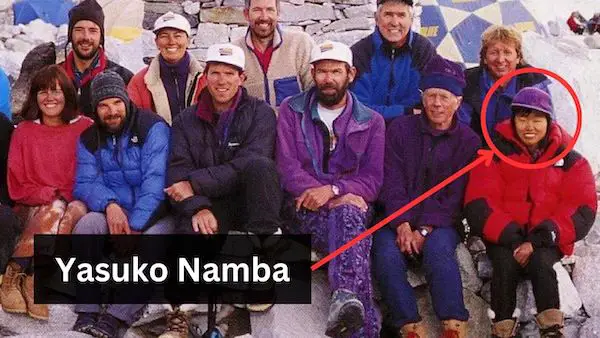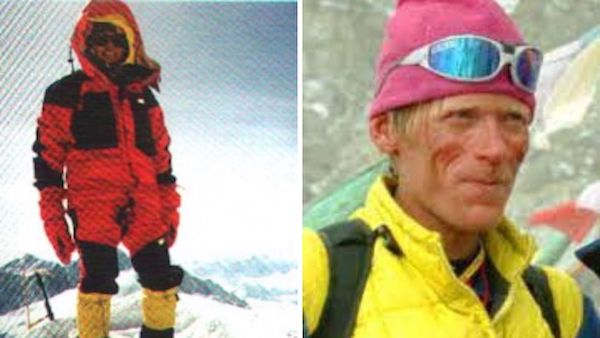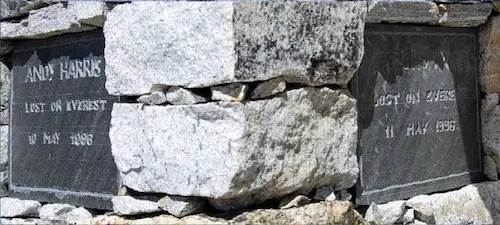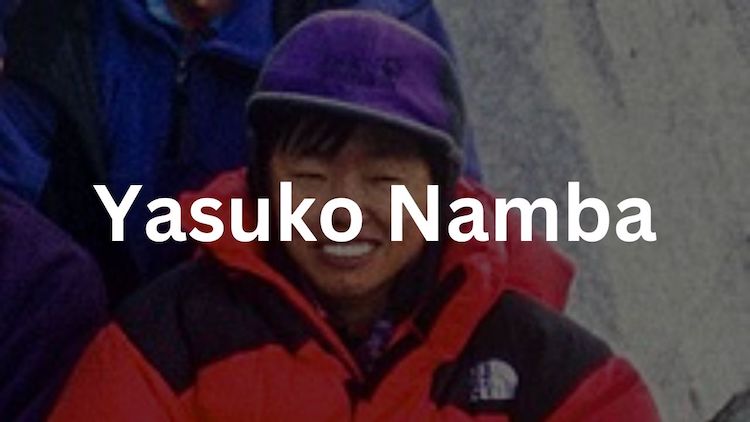Yasuko Namba, a Japanese businesswoman employed by Federal Express, was the second Japanese woman to conquer Mount Everest and complete the Seven Summits. As a member of Rob Hall’s Adventure Consultants team, Namba successfully reached the summit of Mount Everest on May 10, 1996.
Born on February 7, 1949, she accomplished the Seven Summits at the age of 47, earning her the distinction of being the oldest woman to summit Mount Everest at that time. Although her age record was later surpassed by Anna Czerwinska of Poland (age 50).
Sadly however, Yasuko Namba lost her life during the 1996 Mount Everest Disaster, where eight climbers died.
Quick Facts about Yasuko Namba
- Born on February 7, 1949.
- Died May 11, 1996 during the 1996 Everest Disaster
- Yasuko Namba was a Japanese businesswoman and accomplished mountaineer
- She became the second Japanese woman to complete the Seven Summits
- Namba reached the summit of Mount Everest on May 10, 1996
- Was a member of Rob Hall’s Adventure Consultants team
- Namba died from exhaustion and exposure during a snowstorm, about 300 meters from the camp
- Her death led to discussions about the definition of a successful summit in mountaineering
- Guide Anatoli Boukreev expressed regret for not saving Namba and later built a cairn around her body in 1997.
- Her body was recovered in 1997 by husband, Kenichi Namba, and returned to Japan.
Who was Yasuko Namba from Japan?

Yasuko Namba, was the second Japanese woman (with Junko Tabei being the first) to successfully climb all Seven Summits, including Mount Everest, where she tragically lost her life on May 11, 1996. Alongside her career as a businesswoman at Federal Express in Japan, Namba was a mountaineer.
Her mountaineering career started with her summiting Mount Kilimanjaro on January 1, 1982, and Aconcagua in 1984. On July 1, 1985, she reached the summit of Denali, and on August 1, 1992, she climbed Mount Elbrus.
Namba’s ultimate goal was to conquer Mount Everest, which she pursued after successfully ascending the Vinson Massif on December 29, 1993, and the Carstensz Pyramid on November 12, 1994. In April 1996, after completing six of the seven summits, Namba joined Adventure Consultants, to climb Mount Everest.
Yasuko Namba Quest for the Seven Summits:
Yasuko Namba’s mountaineering accomplishments included conquering the Seven Summits in 1996, which represent the highest peaks on each of the seven continents. She started in 1982 with Kilmanjaro and finished in 1996 on Everest. Successfully becoming the second Japanese woman to do so.
Table shows Yasuko’s summit dates for each of the seven mountains:
| Mountain Name | Date of Summit |
|---|---|
| Kilimanjaro | 1982-01-01 |
| Aconcagua | 1984-01-01 |
| Denali | 1985-07-01 |
| Elbrus | 1992-08-01 |
| Vinson | 1993-12-29 |
| Carstensz Pyramid | 1994-11-12 |
| Everest | 1996-05-10 |
Unfortunately, Yasuko Namba died during her descent from Everest. Her death caused debate amongst many climbers, as if her summit of Everest counted or not as she died during the descent. Whereas, many climbers believe that summiting is only half the battle, and you have to return alive to be able to truly say you conquered the mountain.
1996 Everest Disaster Background:

The 1996 Mount Everest disaster is one of the most tragic events in mountaineering history. It unfolded during the 1996 spring climbing season in Nepal as several expeditions attempted to reach the summit.
Among those involved were Adventure Consultants, led by Rob Hall, who had a team of notable climbers including Yasuko Namba, Michael Groom, and Andy Harris. Another team, Mountain Madness led by Scott Fischer, was also attempting the summit.
Unfortunately, unforeseen circumstances, including a fierce blizzard, altitude sickness, and communication breakdowns, led to a series of deadly events. Yasuko Namba, Beck Weathers, a member of Hall’s team, and other climbers were left stranded about 300 meters away from camp when they were unable to find their way back to camp.
Despite efforts to rescue the stranded climbers, Namba, tragically lost her life. Moreover, the disaster claimed the lives of several other climbers, including Rob Hall, Scott Fischer, Green Boots (Tsewang Paljor), Andy Harris, and Doug Hansen.
How did Yasuko Namba die on Everest?

During the descent from the summit, Namba, guide Mike Groom Neal Beidleman, Beck Weathers amongst others, were caught in a snowstorm. Due to the challenging conditions and a whiteout, they became stranded on the South Col and were unable to locate Camp IV.
According to Groom, Namba continued to try putting on her oxygen mask despite running out of oxygen. Recognizing the condition of Namba and Weathers, the guides (Groom and Neal Beidleman) realized it was unsafe to move them towards the camp and decided to wait for a break in the storm instead.
After Anatoli Boukreev, one of Fischer’s guides, realized climbers had not returned, he attempted to organize a rescue from Camp IV. After locating the climbers in the darkness, Boukreev was able to save Sandy Hill Pittman and Tim Madsen. After concluding that Namba and Weathers were dead, or beyond saving, he made the difficult decision to leave them.
The following day, a search team was organized by Stuart Hutchinson, one of Adventure Consultants’ clients, to locate Namba and Weathers. However, Hutchinson once again came to the conclusion to leave them behind in order to conserve resources for other climbers.
While Weathers managed to survive and return to camp on foot, Namba tragically succumbed to exhaustion and exposure. She died around 300 meters away from Camp IV on May 11th.
Boukreev Regrets Not Saving Yasuko Namba

Anatoli Boukreev openly acknowledged that he saw Yasuko Namba when he ventured onto the South Col during the storm in the early hours of May 11, 1996. However, he consistently maintained that he did not encounter Beck Weathers until later that afternoon when Weathers stumbled into Camp IV.
It is worth noting that in his book “The Climb” Boukreev carried a deep sense of remorse, as he believed he failed to rescue Yasuko Namba from dying. He took personal responsibility for not rallying the Adventure Consultants’ team members to join him in the rescue effort. The haunting memory of being unable to return to Namba after successfully leading three other climbers to safety troubled him until he died.
As a testament to his sorrow, on April 28, 1997, while descending Everest with the Indonesian National Team, Boukreev constructed a protective cairn (a mound of rough stones built as a memorial or landmark) around Namba’s body to ward off scavenging birds. A few days later, overcome with emotion, he tearfully apologized to Yasuko Namba’s husband (Kenichi Namba) at a teahouse along Everest’s trekking trail. Despite the Adventure Consultants’ team’s inability to come to Namba’s aid, Anatoli never attributed her death to her teammates.
Was Yasuko Namba’s body ever found on Everest?
Yes, Yasuko Namba’s body was found by Boukreev and an Indonesian National team on April 28, 1997. Her body was recovered and removed by her husband Kenichi Namba in 1997, and taken to Japan.
Kenichi Namba employed a team of sherpas to remove Yasuko’s body from the mountain and have it returned to Japan. After her return to Japan, he gave her a proper burial. The location of the burial site in Japan is unknown.
Remembering The Japanese Climber: Yasuko Namba:

In remembrance of the tragic accident in 1996, two memorial monuments were constructed near Gorak Shep by Sherpas. One memorial honors Rob Hall, while the other commemorates his fellow climbers Doug Hansen, Andy Harris, and Yasuko Namba. These monuments stand side by side, connected by prayer flags, symbolizing their unity in spirit.
According to John Taske, who spoke of Yasuko Namba in PBS’s program “Frontline” for David Breashears’ film Storm Over Everest,
She was a little lady; I’ve never met a girl more determined. About 100 pounds in weight, no more, but as far as determination goes, she was twice that weight in determination. However, nature being what it is, hypothermia, body mass — she had a small body mass; she would have gotten desperately cold much more quickly than an average person twice her weight. And there was very little chance of her surviving in those sorts of conditions.
John Taske on Yasuko Namba

Beck Weathers also spoke about Yasuko after the incident. Stating that Yasuko,
Yasuko was diminutive, and some of her choice of gear reflected that. She had a variety of titanium things, because she could not carry quite the same weight physically. She just didn’t have the body power.
Beck Weathers on Yasuko
Described as a reserved individual, Yasuko possessed a pleasant demeanor and displayed a strong sense of propriety. Once she set her mind on a goal, she exhibited unwavering focus and determination. Among the team, she may have surpassed everyone in terms of sheer drive, dedication, and unwavering commitment to accomplishing her objectives.
Yasuko Namba’s Death on Everest in 1996
Yasuko Namba’s remarkable journey as a mountaineer was cut tragically short by her untimely death on Everest. Despite her petite stature, she possessed the drive, focus, and dedication needed to pursue her goals.
The memory of Yasuko Namba serves as a reminder of the risks and challenges that climbers face on Everest. However, it also shows that no matter who you are, or your size, you can accomplish anything that you want through hard work and determination.
